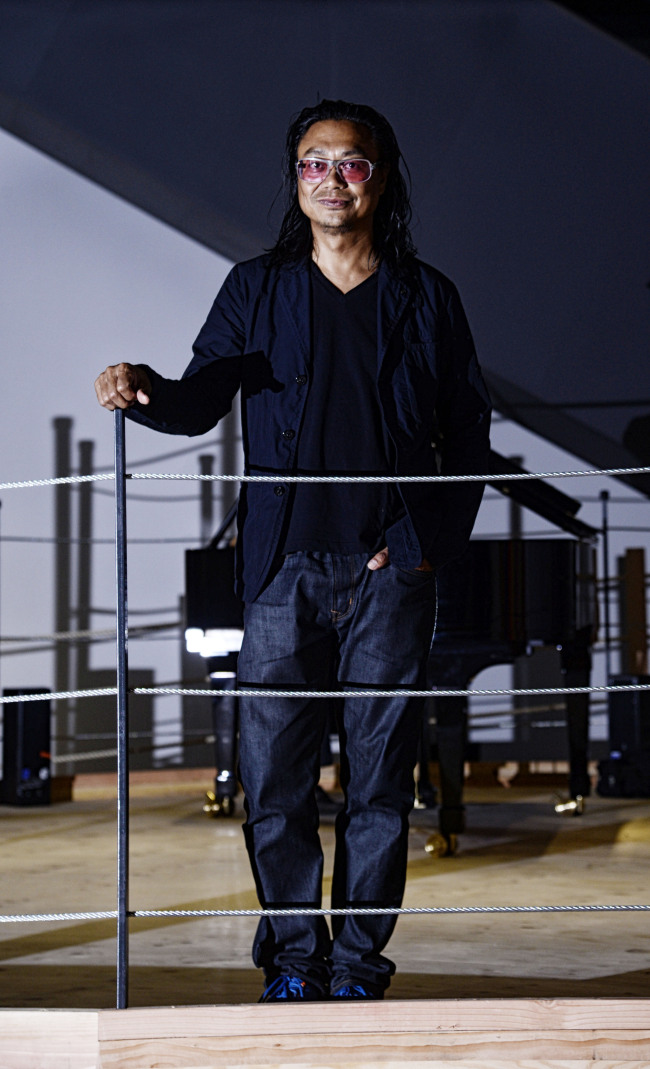[Herald Interview] Breathing life back into museums
Artist Rirkrit Tiravanija’s installation ‘Demo Station No. 5’ becomes an interactive cultural stage at Leeum
By Korea HeraldPublished : Sept. 1, 2014 - 20:24
Artist Rirkrit Tiravanija breaks the typical museum stereotypes.
He cooked and served Thai curry to visitors at a gallery in New York in the early 1990s. What many thought was an opening event continued throughout the exhibition.
He loves eschewing the usual museum paradigm: an artist, artwork and audience. He turned an exhibition space into a live radio broadcasting studio at the Guggenheim Museum in 2005. He set up a bookstore at the 2009 Venice Biennale and a pingpong table at the 2012 Gwangju Biennale.
He cooked and served Thai curry to visitors at a gallery in New York in the early 1990s. What many thought was an opening event continued throughout the exhibition.
He loves eschewing the usual museum paradigm: an artist, artwork and audience. He turned an exhibition space into a live radio broadcasting studio at the Guggenheim Museum in 2005. He set up a bookstore at the 2009 Venice Biennale and a pingpong table at the 2012 Gwangju Biennale.

Tiravanija received the Golden Lion for Best Artist at the 2009 Venice Biennale for his idea.
This time, the artist presents another public-oriented work that invites people to watch and participate in cultural activities at the 10th anniversary exhibition of Leeum, Samsung Museum of Art.
“I imagine people to move around like they are in their daily life. Part of my interest is always to break down the distance between what we think as art or high art and what we do in our daily life,” he told The Korea Herald last week.
The two-story wooden stage will serve as the venue for a fashion show, concerts and performances ― unusual events for a quiet museum. There will be concerts of classical music, Korean traditional music and alternative music, with performances by professional dancers. At the same time, the audience can use it as their own playground, their own stage for piano performances, and a classroom, where they can learn how to play different drums from around the world.
“It’s a platform for people to demonstrate something. It’s about showing your ideas as part of the exchange,” said Tiravanija, explaining the title of the work “Demo Station No. 5.” It is the fifth project in his “Demo Station” series, which started in 2005.
The artist, who works in the United States, Germany and Thailand, said his work was about aspects of people’s lives that others paid little attention to.
His interactive art started from an interest in archaeology. However, he was not interested in the conventional approach of displaying work in a museum, but instead wanted to breathe life back into galleries. He has turned what would have been lifeless installations into places where people can play, interact and share their experience with others.
“When we come to a museum, we expect there’s some kind of meaning or information to learn from displays. We only read and look at what we are told. But we are not really having an experience,” he said.
“I used food a lot in my previous works because it’s something that we all know and understand. It wasn’t about the food, but about people being together in the same place,” he explained.
Recently, he began to work on films about people. The films are about the ordinary lives of a rice farmer in Chiang Mai, a poet and an artist, people that are barely paid attention to. But the 2 1/2 hour film encourages viewers to find meaning and value in the lives of these people from different areas of society.
“These are the kinds of people in the periphery, not someone we focus on every day. But they are important to us. They are poets and artists whose lives we don’t pay attention to. We’re interested in someone like Angelina Jolie, but I think it’s important we see both,” he said.
By Lee Woo-young (wylee@heraldcorp.com)
-
Articles by Korea Herald









![[Kim Seong-kon] Democracy and the future of South Korea](http://res.heraldm.com/phpwas/restmb_idxmake.php?idx=644&simg=/content/image/2024/04/16/20240416050802_0.jpg&u=)








![[KH Explains] Hyundai's full hybrid edge to pay off amid slow transition to pure EVs](http://res.heraldm.com/phpwas/restmb_idxmake.php?idx=652&simg=/content/image/2024/04/18/20240418050645_0.jpg&u=20240418181020)

![[Today’s K-pop] Zico drops snippet of collaboration with Jennie](http://res.heraldm.com/phpwas/restmb_idxmake.php?idx=642&simg=/content/image/2024/04/18/20240418050702_0.jpg&u=)